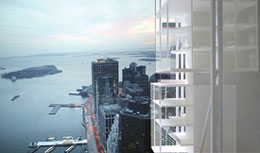 |
| HIGH SPIRIT. Sciame stands tall on the Brooklyn Bridge. (Photo by Guy Lawrence for ENR) |
Frank J. Sciame Jr. has extra-special affection of late for the Brooklyn Bridge. It all began one day in 1999, when he stood on his favorite structure and gazed back at the East River’s historic seaport district. It was there that New York’s intrepid "little developer who can" made up his mind to follow his gut instinct and risk $4 million on a rundown property a stone’s throw from the World Trade Center.
Sciame now calls the decision, taken against advice sought from more-seasoned developers, one of his best. "I looked at 80 South Street and thought, ‘As long as the world doesn’t end, downtown is coming back. And if the world ends, it doesn’t matter,’" he says about the day.
Little could Sciame have imagined that on Sept. 11, 2001, the safe and secure world he and most Americans knew would come to an end. Little could he have suspected that his "bridge" decision would set the stage for his gutsiest course of action. For if the 53-year-old contractor-turned-developer has his way, an 835-ft-tall symbol of New York’s and Frank Sciame’s indomitable spirit will soon shoot up in place of his six-story building.
Why put the building, just recently renovated to house his 29-year-old construction management firm and eight-year-old development company, on growth hormones? Why build a tower that will stand out like a sore thumb, especially in a time of skyscraper skittishness? Why stretch his comfort level and risk his bank account?
Sciame’s reply always is the same. "I don’t think you should go through life looking over your shoulder," he says. "I think you’ve got to stand tall."
Grand gestures are noble, but will people pay $3,000 per sq ft, or as much as $12 million a unit, for the privilege of sticking their necks out so near to Ground Zero?
 |
| HARBOR VIEW. Sciame’s pet high-rise project would dwarf its lower Manhattan neighbors. (Photo courtesy of Michel Hsiung/TEN Arquitectos/© David Sundberg/ESTO) |
Sciame thinks so. He maintains that 9/11 was just a blip on the screen of economic recovery for lower Manhattan, which he predicts will soon find itself at the center of his favorite city’s "emotional heart." Besides, Sciame considers the future residential tower, designed by his newfound favorite "starchitect" Santiago Calatrava, not just a statement about New Yorkers’ resilience but "a true work of art." He might even buy a unit himself. That is, "if I can afford it," he says.
The tower scheme– 12 stacked "glass" cubes, offset to either side of a concrete spine–owes its existence to 9/11. Before terrorists destroyed the twin 110-story towers, Sciame had envisioned a conventional high-rise for 80 South Street. But "after seeing the public making this great commitment to great architecture" at Ground Zero, Sciame felt "the time was right" to alter the skyline along the East River.
 |
| BOOSTERS. Sciame (r.) sits with Burden and other panelists pushing the East riverfront's revival. (Photo by Nadine M. Post for ENR) |
The developer is called a pioneer and a visionary for his dogged pursuit of the tower scheme. "80 South Street is so critically important," said Amanda Burden, New York City’s planning commissioner, at a recent forum on the East riverfront’s revival. "The building can do an enormous amount to revitalize lower Manhattan," she added.
Gerard Neumann Jr., of the local marine constructor, Spearin, Preston & Burrows Inc., calls Sciame "energetic, smart, driven, dedicated to improving life in New York and honest."
Revving Up
What started his engine? Though no Horatio Alger, Sciame hails from humble roots. The son of a union painter who labored seven days a week, his parents and two sisters lived in his grandparents’ house in Brooklyn. The household, he says, was filled with "a great mix of love and a moral compass." But watching his parents work so hard made him determined to give his own family "more than we had," he says.
|
Sciame started out studying engineering at City College of New York, but found the math too theoretical. His love for buildings prompted him to switch to architecture. And his love for building prompted him to start F.J. Sciame Construction Co. Inc. His first job, repairing a gate for New York University, paid $75.
Sciame soon was using his training as an architect not only to help manage construction projects but grow his business. Sciame, ranked 67 on ENR’s Top 100 CMs-at-risk list in 2004, has a staff of about 100 and $500 million of projects under way.
Sciame has a varied roster of commercial, institutional and residential CM jobs, including new construction, interiors and historic restorations. Completed projects include the $45-million Museum of Jewish Heritage and the $10-million restoration of the New Victory Theater. Currently under way are the $65-million expansion of the Pierpont Morgan Library and the $46-million Historic Front Street at the South Street Seaport, near 80 South Street. For that, Sciame also is the developer with two partners.
Sciame is known for having the eye of an architect, the skills of a contractor and the instincts of a deal-maker. Clients like "the breadth and depth" of his teams, as well as excellent and timely performance and concern for design, quality and economy. "He’s almost a patron of the projects he works on, like a modern Medici," says Stephen V. DeSimone, president of DeSimone Consulting Engineers, the local structural engineer of record for the tower.
"Every architect in New York City wants to have a building built by Frank Sciame," says one architect.
Sciame is the 2004-05 chairman of the New York Building Congress. Richard T. Anderson, the group’s president, calls his temporary boss "an extraordinary person, with an incredible ability to capture the total picture."
|
Sciame’s chairmanship is just one of his myriad activities. Among other commitments, he serves on the boards of the City College Fund, the South Street Seaport Museum and the New York Landmarks Conservancy. He chairs the Seaport North Community Business Association, which he helped organize.
What keeps Sciame’s engine revved, besides his wife Barbara of nearly 29 years and his four children, ages 17-24? One clue is the writing on the corridor wall leading to the office squash court. Hand-picked by Sciame, a great believer in inspirational sayings, they are from The Winner Within, by famed basketball coach Pat Riley. "You must give every bit of energy you have to win by an inch," says one. "You must be willing to raise the stakes, take on responsibility and follow through doggedly until the job is done," says another.
One of Sciame’s favorite off-the-wall sayings is "non-illegitimi carborundum." He says it means "don’t let the bastards grind you down." The phrase helps him get through the rough times in construction, an industry he calls, "unfairly difficult," at least in his favorite city, New York.
The 2000 purchase of 80 South Street was not Sciame’s first move based on gut instinct. His first deal was the purchase for $1 of a landmark row house in the ailing seaport district. He expanded and renovated the property, which was crumbling at the time. It now is worth millions.
High-Wire Act
Sciame’s all-time most daring enterprise is the tower. If all goes well, construction could begin as soon as late next year or early 2006 and take two years.
 |
| TOWER POWER. Calatrava designed Sciame’s cube tower to echo the Brooklyn Bridge towers. (Rendering courtesy of Santiago Calatrava S.A. & David Sundberg/Esto) |
Sciame’s reputation among architects actually led to his introduction to his architect. In 2002, when Calatrava’s Manhattan townhouse renovation needed a push, Calatrava’s architect recommended Sciame as construction manager.
In the two years since, their relationship has blossomed. "He’s the real thing," says Calatrava. "I have never met someone as passionate or as enthusiastic."
Their mutual admiration aside, the road to the residential tower commission, for which Calatrava is architect and design engineer, was bumpy. In 2003, after producing two study models in quick succession, Calatrava returned Sciame’s check. He explained that, regrettably, he was unhappy with his initial concept and due to other obligations, unable to pay proper attention to the project.
Six months later, Sciame got a call from Calatrava. "Were there any height restrictions on the building?" he asked. "Virtually none," was the answer. Those were the magic words. "Calatrava’s enthusiasm returned," says Sciame. "I forwarded a larger honorarium and we were on our way."
The rest is history in the making.

Post a comment to this article
Report Abusive Comment